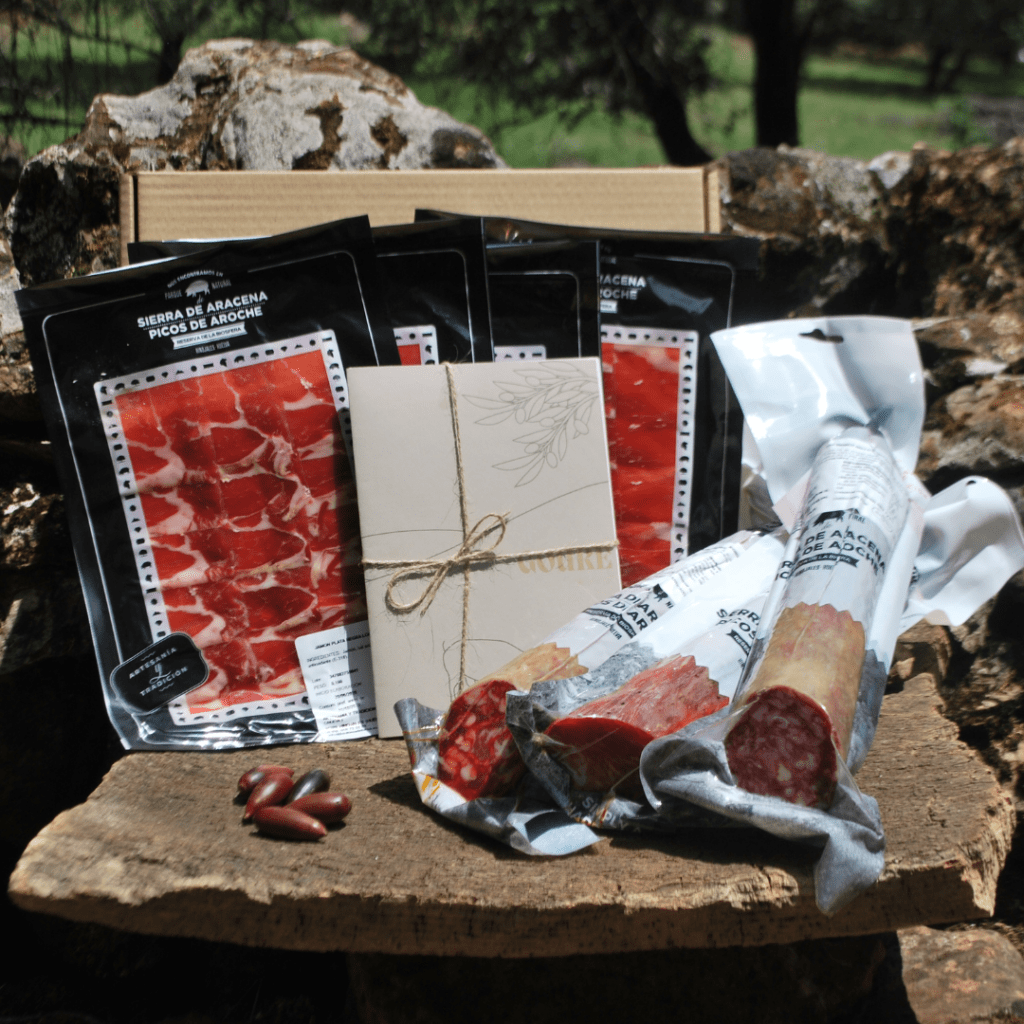Spanish Salchichon
Spanish salchichón is a type of cured sausage that is popular in Spanish cuisine. It is made from pork, spices, and other ingredients, such as garlic and paprika, and is typically aged for several months to develop its flavor. Spanish salchichón is known for its slightly sweet, smoky, and spicy taste, and is often made from the meat of Iberian pigs, a breed of pig native to the Iberian Peninsula, which includes the countries of Spain and Portugal.
¿Qué te apetece?
FAQ: Spanish Salchichon
Looking for a flavorful and delicious addition to your charcuterie board? Try Spanish salchichón, a type of cured sausage that is popular in Spanish cuisine. Salchichón is made from pork, spices, and other ingredients, such as garlic and paprika, and is typically aged for several months to develop its flavor. It is known for its slightly sweet, smoky, and spicy taste, and is often made from the meat of Iberian pigs, a breed of pig native to the Iberian Peninsula.
Spanish salchichón is usually made from the leaner cuts of pork, such as the loin or shoulder, and is typically leaner and drier than other cured sausages, such as chorizo. It is typically sliced thin and eaten as a snack, or tapa, on its own or with bread and cheese. It is also commonly used in a variety of dishes, such as omelets, sandwiches, and stews.
If you’re a fan of Spanish cured sausage, you’ll love salchichón iberico, or Iberian salchichón. This delicious sausage is a true taste of Spain and is sure to impress even the most discerning palate. Try it today and experience the flavor of authentic Spanish salami.
Salchichón is usually made from the leaner cuts of pork, such as the loin or shoulder, and is typically leaner and drier than other cured sausages, such as chorizo. It is typically sliced thin and eaten as a snack, or tapa, on its own or with bread and cheese. It is also commonly used in a variety of dishes, such as omelets, sandwiches, and stews.
There are several different types of salchichón, each with its own unique flavor profile and ingredients. Some popular varieties include salchichón de Vic, which is made with pork, garlic, and black peppercorns, and salchichón de Pamplona, which is made with pork, paprika, and white wine. Salchichón is an important part of Spanish cuisine and is enjoyed by many people around the world.
where is spanish salchichon produced?
Spanish salchichón is produced in Spain and is made from pork, spices, and other ingredients, such as garlic and paprika. It is typically aged for several months to develop its flavor. Spanish salchichón is known for its slightly sweet, smoky, and spicy taste, and is often made from the meat of Iberian pigs, a breed of pig native to the Iberian Peninsula.
Spanish salchichón is produced in several regions of Spain, including Andalusia, Extremadura, and Castilla-La Mancha. The production of Spanish salchichón is regulated by the Denominación de Origen Protegida (DOP), or Protected Designation of Origin, which ensures that the salchichón is made according to traditional methods and meets certain quality standards.
Spanish salchichón is a popular and traditional food in Spanish cuisine, and is enjoyed by many people around the world. It is often served as a tapa, or small snack, and can be eaten on its own or as part of a larger meal. It is also commonly used in a variety of dishes, such as omelets, sandwiches, and stews.
How is the spanish salchichon produced?
Spanish salchichón is produced in Spain from pork, spices, and other ingredients, such as garlic and paprika. The production of Spanish salchichón involves several steps:
- Selection of the pork: The pork is carefully selected for its size and quality.
- Grinding: The pork is ground to a fine consistency.
- Mixing: The ground pork is mixed with spices, such as paprika, garlic, and black pepper, and other ingredients, such as salt and vinegar.
- Stuffing: The mixture is stuffed into natural or artificial casings, depending on the type of salchichón being produced.
- Curing: The salchichones are left to cure for several weeks to several months, depending on the size and type of salchichón being produced. The curing process helps to preserve the meat and also contributes to the flavor of the final product.
- Drying: After curing, the salchichones are hung to dry in a well-ventilated area for several months to a year. This allows the meat to lose moisture and develop its characteristic flavor and texture.
- Slicing and serving: The salchichones are sliced thin and served as a tapa, or small snack, or used in a variety of dishes, such as omelets, sandwiches, and stews.
Spanish salchichón is known for its slightly sweet, smoky, and spicy flavor, and is a popular and traditional food in Spanish cuisine. It is enjoyed by many people around the world.






